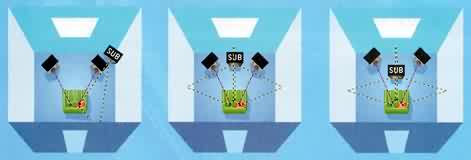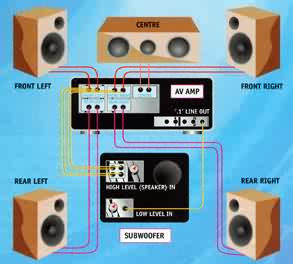Replaying bass is a very tricky thing, it adds a lot of trouble to speaker designers and audiophiles. But this is also a challenge, and the potential rewards fully prove that it is worth the effort to improve bass reproduction.
The core of the problem is that the speakers are not operating in an isolated environment, but many speaker designers and Hi-Fi audio enthusiasts often ignore this. Designers always use the anechoic room isolated from the actual environment to develop their product. Practice has proved that the sound quality of the speakers and the actual listening room have a very close mutual influence relationship, especially in the bass frequency band. As we all know, the frequency range of human ear listening is about 20Hz lowest to 20000Hz highest, and its span is about 10 octaves. The central C sound of the piano is located in the fourth octave from the lowest central. Therefore, the bass range itself is almost confined to the lowest octave (20Hz ~ 40Hz) and the second octave (40 ~ 80Hz) above it, although pure bass is not much heard in real life , But it plays an important role in creating the authenticity and intensity of music.
If you don't use a subwoofer and rely on ordinary speakers to create bass, this speaker is not only bulky, but also very bulky. The subwoofer has many advantages, such as small size, unobtrusive placement in the room, its own amplifier and filter in the box, and no additional requirements for the system. The system has a subwoofer that specifically reproduces bass, and other channels can use smaller speakers. The configuration and use of the entire system are more flexible and convenient. Generally speaking, the creation of bass requires the use of larger speakers, but as long as a pair of ordinary small speakers are placed on the side of the wall, it is enough to dive the replayed sound into the mid-bass range. Part of the reason is that it is helpful to enhance the bass of 50Hz ~ 100Hz when placed on the side of the wall. Another part is that the "standing wave resonance" caused by the shape and size of the room provides the "room gain effect". The common problem of most commercially available subwoofers is that the low-end roll-off frequency cannot be dived below 50 Hz, and their frequency response cannot be ideally matched with ordinary speakers of other channels, and part of their frequency response often constitutes harmful overlap. phenomenon.
â— The impact of standing waves
Every room, whether it is a concert hall or the living room of an ordinary family, has a standing wave phenomenon, which is the main source of bass playback problems. The frequency of the standing wave is closely related to the size of the room. In a concert hall with a large indoor space, the standing wave frequency occurs in the lowest bass and subsonic regions, which is lower than the lowest frequency of the bass instrument, so it will not adversely affect bass playback. However, in the small living room of ordinary families, due to the small size and space of the room, the generated standing wave frequency will be higher and enter the bass region of the music, and overlap with the latter, making the sound quality worse. While standing wave provides "room gain", it also makes the frequency response of the bass region very uneven, that is, it will increase the response of some frequencies and cancel the response of other frequencies. In addition, different rooms have different standing wave modes, and it is related to many factors such as wall materials, furniture, listening position and speaker placement in the room, and it is difficult to accurately predict it.
â— Create bass indoors
As we all know, in order to make the speaker emit sound, we must use the vibration of the cone to move the air molecules, and excite sound waves in the air with the same frequency as the vibration frequency of the cone. Because the frequency of the bass is very low, and the vibration speed of the woofer cone is also very slow, so to produce strong bass in the room, the cone must be moved a large number of air molecules in a unit time. To achieve this, subwoofers usually use large diaphragms and small-stroke cones or small diaphragms and large-stroke cones. The latter's small cone diameter is conducive to reducing the volume of the entire subwoofer, and has the advantages of high power and high loudness. It has become the mainstream of modern subwoofers.
However, the subwoofer is installed in a huge speaker, although it can reproduce some of the shocking explosions and landslides in the movie, but when listening to music, a lot of high Intensity of heavy bass can be very unpleasant. In addition, research and practical results have shown that making the subwoofer louder than the other speakers in the system does not have much practical significance. These are the reasons why the volume of modern subwoofers is made smaller.
â— Positioning and connection of subwoofer
The inherent variability and unpredictability of indoor standing waves make people have no choice but to tolerate them. Although some computer software provides some interesting methods to control the standing wave, it does not completely solve the standing wave problem. Fortunately, the wavelength of the bass is much larger than the size of the ordinary room, and the bass has no directivity. Taking advantage of this feature, the average user only needs to use a separate subwoofer to obtain almost unlimited freedom to test the optimal placement of the subwoofer indoors. Although its placement is not as important as the main speakers, different placements still have different sound effects. The following introduces the placement of three subwoofers, each of which has its own advantages and disadvantages, readers can choose according to the experimental results.
Place the subwoofer in the corner of the wall (Figure 1). This method helps to avoid the sound reflection in the room, making the reproduced sound more clear and vivid. But at this time, the indoor mode gets stronger excitation, which will make the bass response not flat enough. Since the subwoofer is farthest from the listening position in the entire system, the bass sound heard will be slightly delayed than the sound of the main speaker. When placed, the subwoofer should be at least 10cm away from the wall.

From left to right: Figure 1-The subwoofer is placed in the corner, Figure 2-The subwoofer and the main speaker are placed in a line, Figure 3-The subwoofer is placed in the listening area
Place the subwoofer and the main speaker on the same line (Figure 2). At this time, the distance between the subwoofer and the main speaker is the same as the listening position, so the direct sound from the three speakers reaches the listener's ear almost at the same time, and there will be no time difference. The disadvantage of this arrangement is that the indoor reflected sound increases, and these delayed reflected sounds will reduce the clarity of the reproduced sound.
Place the subwoofer close to the listening area (Figure 3). This method is worth a try, especially for some rooms where it is difficult to obtain the best sound effect, because it minimizes the excitation of the indoor mode, and also greatly shortens the direct sound transmission path and the bass reaches the listener's ear Time, but at the same time it also makes the indoor reflected sound more blurred.
Another less scientific method of positioning is to first place the subwoofer on the seat where you usually listen and let it play music, then slowly move around and listen to the music carefully at the same time until you find the best bass sound quality The better point. This point is the best place to place the subwoofer, and finally place it there.
In addition to the two sets of high-level (speaker level) output terminals connected to the left and right main channel speakers, the modern home theater AV amplifier also has a low-level (line level) output terminal, active subwoofer speakers It has corresponding input terminals. In order to make the system have the best sound effect when playing music and movie programs, in addition to connecting the two sets of speaker level input terminals of the subwoofer to the corresponding output terminals of the AV amplifier, the line level of the two should also be connected. The terminals are also connected accordingly, as shown in Figure 4. The advantage of this connection is that when the system plays two different programs of two-channel stereo music and 5.1-channel movies, the bass can be effectively enhanced.
â— Some controversies about bass
At present, there is still some controversy about the role and effect of bass. One of the easier-to-understand points is, "The subwoofer can enhance the bass strength of the sound system." However, many people think: "Adding extra bass can also improve the characteristics and sound quality of the midrange and even high-frequency segments" The subwoofer can improve the depth of the stereo sound field "," Increasing the bass extension can disrupt the original role of the main speaker. If the relative level of bass and treble is deliberately selected, they can also cancel each other on both sides of the middle audio section. " ... Wait, these views are quite difficult to understand. Although it is still difficult to provide scientific explanations for these views, there are many "evidences" that are widely circulated. Some psychoacoustic phenomena are also often difficult to understand, and history shows that in the development of high-fidelity technology, certain subjective methods are often more authoritative and influential than theoretical assumptions. From this point of view, many problems in the audio field still need to be explored in depth.

Figure 4 Subwoofer connection

Follow WeChat

Download Audiophile APP

Follow the audiophile class
related suggestion
